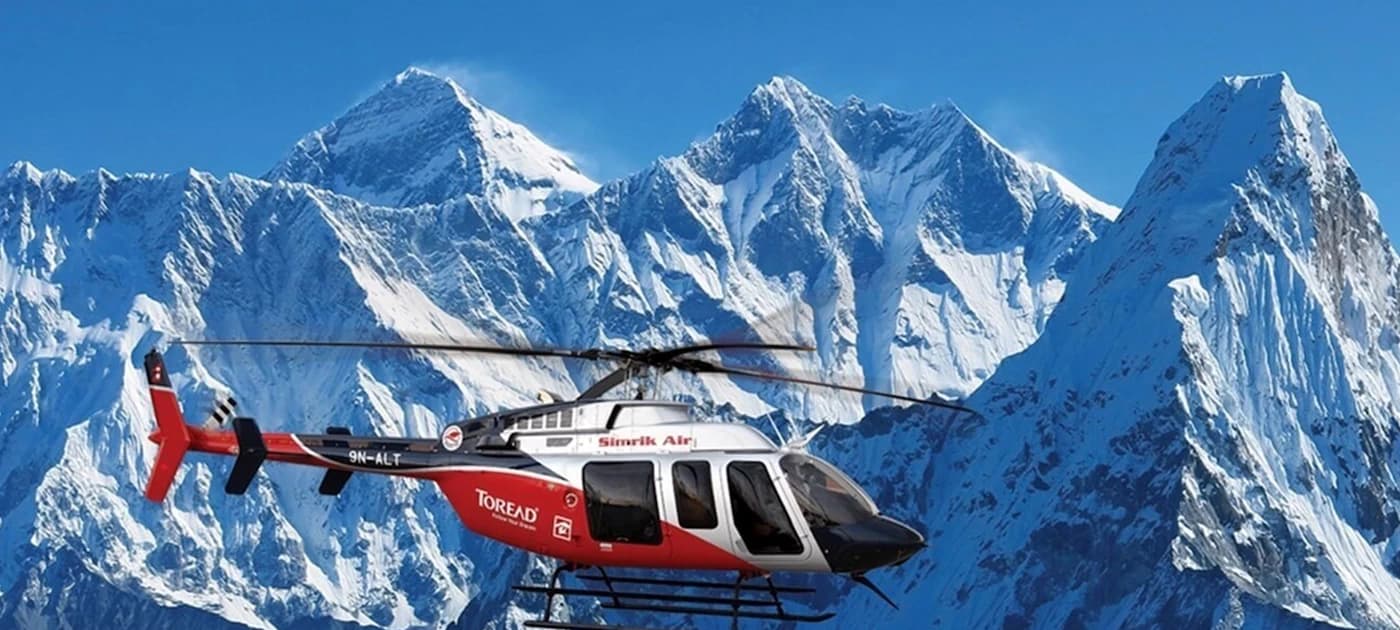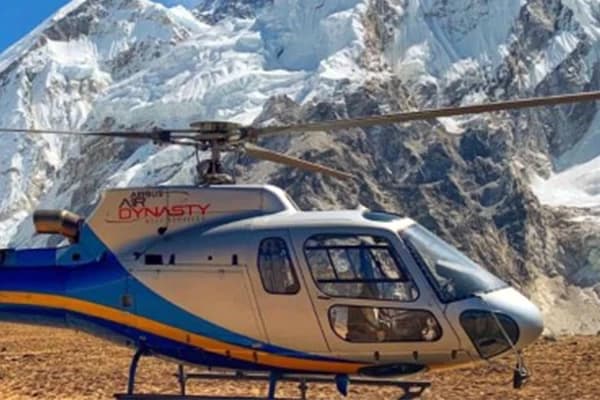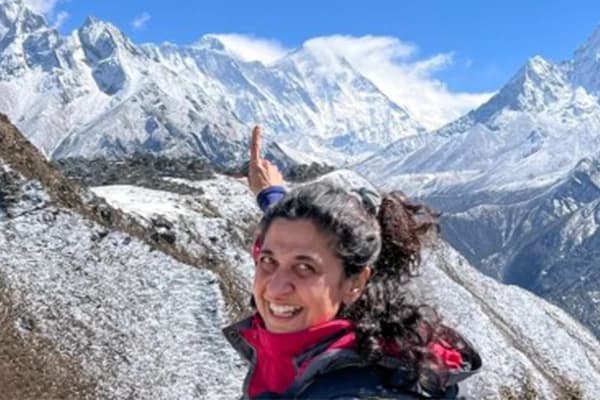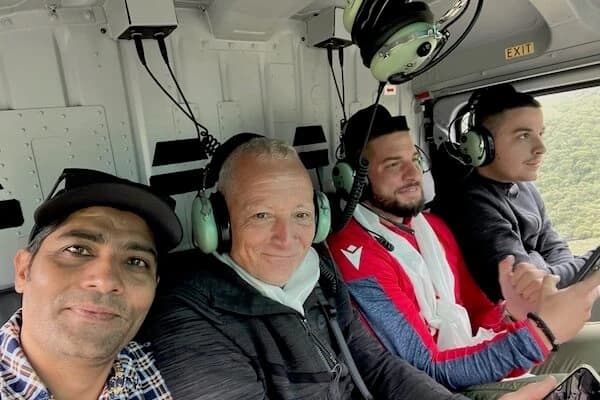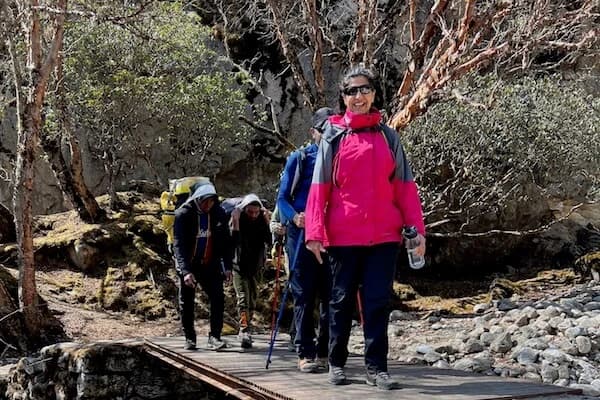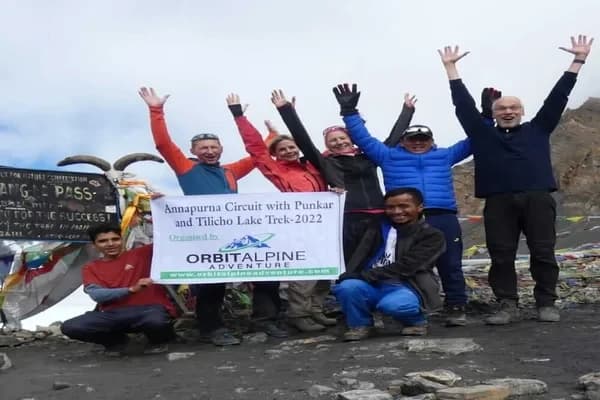This area of Everest, with the uppermost peak in the world, Mount Everest, offers two different ways to any explorer who approaches it: the first being the Everest Base Camp Helicopter Tour and the other being the Everest Base Camp Trek with Helicopter Return. Both provide stunning views and allow explorers to see the anonymity of the Himalayas but with numerous likings, time limits, and physical skills.
Everest Base Camp Helicopter Tour Vs Everest Base Camp Trek with Helicopter Return
A helicopter tour of Everest Base Camp is all about those with the wants of fast, comfy, and remarkable visual trips in mind. Within a day from either Kathmandu or Lukla, the tour will present a whole region and the inflight view of the great Mt. Everest with its immense peaks, glaciers, and the amusing Everest Base Camp. It's an easy-going experience that needs the least physical fitness and is best for short-time tourists or those who just want to enjoy the comfort and lavishly enjoy the sight of the glory of Mt. Everest.
On the other hand, the Everest Base Camp Trek with Helicopter Return is a complete journey that offers the state of trekking in the Khumbu region and the peacefulness of a helicopter flight back to Lukla or Kathmandu. This is the perfect option that works for those attracted by the local cultural experience, the rough physical and high-altitude trekking, and the slow approach previous to reaching Everest Base Camp. Truly connect with the scenery, the Sherpa community, and the journey itself, culminating in the ultimate reward of reaching Everest Base Camp on foot before your deluxe return by helicopter.

In this effort, we will sightsee the outstanding points, advantages, and disadvantages of both the Everest Base Camp Helicopter Tour and the Everest Base Camp Trek with Helicopter Return, letting you decide which is best for you about your motivations.
Overview of Experience
Helicopter Tour to Everest Base Camp
A lavish and time-saving way to enjoy the amazing beauty of the Everest region, the Everest Base Camp Helicopter Tour is considered for those people who want to marvel at the grand Himalayas but are unable to meet the physical difficulties needed for trekking. In those few hours, this short tour provides an overall view of the world's uppermost peaks, glaciers, and rocky terrain.
What is also important is that usually, trips start from either Kathmandu or Lukla. You can see such iconic places as the Khumbu Glacier that dramatic icefall area, and the high summits of Everest, Lhotse, and Ama Dablam. One of the tourist attractions of the journey is a stop at Kala Patthar, which is viewed as the best vantage point for an up-close all-around view of Mount Everest and its near peaks. This brief stop allows passengers to step out and soak in the spectacular views from 5,545 meters.
The whole trip, with flying time and stops, takes a normal of 4-5 hours, which is both seamless for those with a minimum of time and for those who look for comfort and ease on the same trip all day long. The Everest Base Camp Helicopter Tour provides a unique bird's-eye view of the great Himalayas that, too, with an understanding of a lifetime—the real moment without sweat and struggle in trekking.
Everest Base Camp Trek with Helicopter Return
Everest Base Camp Trek with Helicopter Return is an attractive journey, combining challenge and luxury. The trek is a journey with the association of inspiring oneself physically by trekking through the middle of the Himalayas and experiencing the extravagance of a helicopter trip back to Lukla or, on the other hand, a direct journey straight to Kathmandu. It takes 9 to 10 days and offers the trekker deep immersion in the heart of the Everest region. You rise slowly through the ever-changing scenery, from the lush forests of the lowlands to the high desert.

The journey starts in Lukla and continues to the famous Sherpa village of Namche Bazaar, Tengboche for a visit to their monasteries, and on to the uppermost point of Dingboche, Lobuche, to finally reach Everest Base Camp, where you can see the superb Khumbu Glacier and the together mountains.
After the satisfying attainment of success, the goal of Everest Base Camp, and perhaps even climbing Kala Patthar for better sights, the trip finishes with a helicopter ride back. Besides the sight and comfort this return flight will offer at the end of your trek, there will be an exclusive bird's eye view of the kind of topography just covered. The Everest Base Camp Trek with Helicopter Return is appropriate for adventure-seeking, traditionally rich, and deeply filling experiences in the Himalayas.
Landscape and Scenery
Everest Base Camp Helicopter Tour
The Everest Base Camp Helicopter Tour has been defined as a bird's flight in close closeness to the Himalayas, which describes all the sights you will have during the flight. Get to see a close view of some of the highest peaks in the world, such as Mount Everest, Lhotse, Nuptse, and Ama Dablam. You will also be flying over the Khumbu glacier and the well-known icefall, with a brief halt at Kala Patthar, where one can fulfill his dream: a 360-degree view of the Everest range. The pure beauty of the region is truly incredible from the air.
Trek with Helicopter Return
The helicopter tour gives a summary of the scenery, but trekking takes one through it. You will be trekking through compact forests, crossing suspension bridges over deep valleys, wandering through traditional Sherpa villages, and climbing into high desert lands. The gentle slope will allow you to walk across the evolution of ecosystems: from the solid pine forest to the infertile, rocky scenery above the tree line. The trek offers a close connection to the environment with the sights of the mountain gradually building to their magnificence, forthcoming up to Everest Base Camp.
Cultural Immersion
EBC Helicopter Tour
The heli tour, though gives an all-around view, is short. You will come very close to the local culture and people. As the heli tour is based exclusively on the outlook of the valley rather than the cultural engagement. But you shall come for a short time to meet the Sherpa community while you make a stopover, liable on your itinerary.
EBC Trek with Helicopter Return
Also, it is rich in cultural experiences that give a taste of networking with the local Sherpa community. Rest overnight traditional teahouses, visits to monasteries, and interaction with local people are inherent in and around the Khumbu region. The journey goes through some of the most famous Sherpa villages, including Namche Bazaar, the core of the Khumbu region, and the mountain village of Tengboche, including the praised Tengboche Monastery. This journey gives one a knowledge about the type of life the Sherpas had lived, their religiousness, and other life relations regarding the mountains.
Physical and Psychological Strains
Helicopter Journey
The Everest Base Camp Helicopter Tour is a seamless option for those concerned with seeing the majesty of Everest without facing its physical adversity. With no earlier preparations required for the Everest Base Camp Helicopter Tour, there is a very low chance of having altitude sickness as the time that one spends on high height is short. All can go on this tour, without having to be concerned about age and level of fitness.

Trek with Helicopter Return
It is a physical quest that demands to be in good shape. At times, it goes over 4,000 m, where the air is thin, also the risk of height sickness in the blood; the hiking days are long. This journey also bears mental challenges since the land is rocky, the weather unpredictable, and the journey long. But the sense of accomplished success upon arrival at Everest base camp, and the scenes that this walk offers, in the end it is all valuable. The helicopter return can sit back and take in while experiencing data without the physical interruption that would arise from the return trip.
Time and Convenience
Helicopter Tour
It is extremely time-saving given that it is appropriate for those who are functioning on a busy schedule or those who do not have enough time. The complete time will only consume half of your day, and by midday, you can have a gorgeous set of the Everest and therefore, have you back in the hotel. This decision is best for those who wish to have a short and comfortable experience of the Everest region.
Trek with Helicopter Return
The journey, on the other hand, needs much of a holiday since it often has a period of close to 9 -10 days. This may troublesomeness the people with the minimum time, but they can have a shorter distance sight in the Everest region. The helicopter return leaves the touch of luxury and ease in saving time and all the energy of the return trip but still experiencing the taste of having arrived at Everest Base Camp.
Cost Considerations
Helicopter Tour
The Everest Base Camp Helicopter Tour is a very high-class one; it costs so, too. Depending on whom you fly with, the type of helicopter, and the time of year, the prices will differ, but it is normally on the pricier side. However, the price includes extravagance services like pick-up and drop-off at your hotel, your own or shared helicopter, and sometimes even a gourmet breakfast at a hotel that is at a very high height.
Trek with Helicopter Return
However, the overall cost for that journey with a helicopter return can also be very high and provides a wide series of price options. Quality of lodgings, service inclusions such as porters and guides, and likes to take a private or group tour are some of the factors directly related to the cost. Though more expensive still, this option is flexible on budget, and you have the added advantage of high hiking that comes with the extravagance of the helicopter return.
"Note: Before visiting, do confirm which is the best time for everest base camp helicopter tour so that you can make your trip successful easily by minimizing the obstacles."
Environmental Impact
EBC Heli Tour
Helicopter tours, as compared to trekking, are more convenient and dramatic but, at the same time, have a much increased environmental impact. The carbon footprint of conducting helicopter flights in the delicate Himalayan ecosystem is large. Helicopter noise adds to the stress of local wildlife and interrupts the peacefulness of the mountains. With the development of tourism in the Everest region, there is a consistent increase in demand for helicopter tours.
EBC Trek with Helicopter Return
Trekking through, if undertaken sensibly, can be less harmful to the environment than helicopter tours. While it's true that walkers will add to the environmental degradation such as hikers, many of the operators are contributing other environmentally-friendly services like waste disposal and maintainable tourism programs. The carbon footprint exists over the helicopter return, although it's not as substantial as a full helicopter tour.
Altitude and Acclimatization
Helicopter Tour
The helicopter tour is a quick ascent to a high altitude where there is a very short period for adjustment. The tour is, however, sufficiently designed to avoid the risk of height sickness because less time is spent at the high altitude. Adaptation is however different from one individual to the other due to the change in attitude, and thus people are enough to have altitude sickness. The risk remains quite low given that most operators are well-equipped to deal with any rising issues.
Trek with Helicopter Return
Steady acclimatization is possible as the journey progresses, so the chances of getting altitude sickness decrease. Rest days are taken at vital places, like Namche Bazaar and Dingboche, for adjustment to take place in the body. In this way, it is safer to increase the chances of reaching Everest Base Camp for long hours or overnight stays. The helicopter return will save you from a long downhill to the valleys, which might help you in a case where you have spent a longer time at hiking heights.
Safety Precautions
Helicopter tour
Helicopter tours, on the whole, are safe, though there remain some risks that are taken. The high- altitude, unpredictable weather conditions, and rough territory of the Himalayas offer many challenges, but a good operator will detect high standards of protection, i.e., highly experienced pilots, provide safe briefs, and confirm that their helicopters are systematically serviced.
Trek with Helicopter Return
It is a physically energetic journey with pressures from altitude, weather conditions, and the challenge of physical stamina. The homework includes physical training, adjustment along safety procedures. The helicopter return adds the safety feature even more in case of an emergency like severe height sickness or injuries.
Personal Experience and Satisfaction
Everest Helicopter Tour
Everest Base Camp Helicopter Tour – This thirty-minute experience will give even the most extravagant, comfort-looking person an impressively beautiful bird's eye view of the Himalayas. The experience is short, and in personal gratification, a trek may serve since this is purely visual. This package includes a Helicopter Return Trek.
Everest Base Camp Trek Return By Helicopter
It's a life-changing touch on the land and culture and the footraces of the high-altitude trek. Walking to the foot of Mount Everest is always an achievable achievement with determination, purpose, strength, and roughness. The helicopter return gives a perfect closure to the success—an attempt to enjoy the triumph while flying over, at the top, of the occupied bounce of land.
For Whom
Helicopter Tour To Everest Base Camp
The Everest Base Camp Helicopter Tour suits:
- The time-bound travelers.
- For the luxury and comfort prioritizing travelers.
- The people who are physically handicapped and innately afraid to trek.
- The tourists who want a brief view and scenic flight
Everest Base Camp Trek with Helicopter Return
The Everest Base Camp Trek with Helicopter Return is going to suit:
- Wild-spirited Adventurers.
- Tourists and travelers who want an authentic cultural cum natural exploration.
- People who can afford time and energy for multi-day hiking.
- People willing to have both the trekking excitement and luxury of returning by helicopter
Conclusion: Which One to Choose?
The bottom line is that you can pick the Everest Base Camp Helicopter Charter or the Everest Base Camp Trek with Helicopter Return, which is very personal, grounded on your personal goals, time frame, and the amount of journey you desire. Each experience has a different look at joining the Everest region, which is enormously inspiring but provides to different types of tourists.
Everest Base Camp Helicopter Tour is certainly the most desirable for anyone who explorations for a rapid, kind, and amazingly beautiful journey. It offers visitors a bird's eye view of the Himalayas that is truly treasured in a duration of a few hours. It is the best for anyone with either less time or physical limitations in chasing and selecting comfort and comfort. In the Everest base camp trek with helicopter return you take a flight from the window of the helicopter, and the world's uppermost peaks and glacial view can be confirmed very near as the Everest Base camp, but without the energy of effort on foot.
Compared to this adventure, that of the Everest Base with Helicopter Return is complete in-depth. Of special interest to individuals is the desire to hold the challenge of trekking through the rough land of the Khumbu region, the formation of the trail, and the movement toward Everest Base Camp. The journey lets one make a fuller connection with the land, the people, and the journey itself, giving gratification to the core when arrival takes place at the base camp of Everest on foot. A helicopter return at the end of the journey brings a touch of extravagance to an otherwise rough adventure.
After that, either choice leaves you with an experience of a lifetime to one of the truly iconic destinations in the world. Whether you choose the inflight scene of the helicopter tour or the immersive journey of the trek, your adventure in the Everest region will be across sceneries that you will be in wonder of all your life, under the great, tall peaks of the world and the excellent sceneries of the Himalayas.
Frequently Asked Questions of Everest Base Camp Helicopter Tour
1. Time needed for Everest Base Camp Helicopter Tour
On average, this tour will take 4-5 hours. This includes the duration of the flight and ground time spent at key viewpoints such as Kala Patthar.
2. Does the Helicopter Tour have any physical requirements?
Helicopter tours are never physically demanding. That means this tour is good for any fitness level.
3. Cancellation in the weather for doing a Helicopter Tour?
Yes, the weather is mostly subject to change and due to safety reasons, the tour may get delayed or at times canceled.
4. What to wear on the day of the Helicopter Tour?
Make sure you have multiple layers of warm clothes on, as it feels cold in the higher regions. One is suggested to have a down jacket, gloves, hat, and sunglasses.
5. Is there a weight limit for the Helicopter Tour?
Yes, helicopters do have weight restrictions. The approximate weight restriction per passenger is 100-120 kg. For those above this weight, extra charges may be applied.
6. Will I be sick at this altitude during the Helicopter Tour?
With such small stoppages at this huge height, there are very few chances of getting sick due to altitude.
7. Do I need to get a permit?
For helicopter tours, you generally require the following permits:
- Sagarmatha National Park Entry Permit: This is needed to visit the Sagarmatha National Park, site of the Everest Base Camp. You can get this permit in either Kathmandu or at Monjo near the park entrance.
- Pasang Lhamu Rural Municipality Permit: This is a local permit required for entering the Solukhumbu region, where the Everest region is located. It can be obtained in Lukla or at the park entrance.
Everest Base Camp Trek with Helicopter Return FAQs
1. How many days does the Everest Base Camp Trek with Helicopter Return take?
The trek usually takes 9 to 10 days, depending upon the itinerary, including acclimatization days and the helicopter return.
2. What fitness level does the trek require?
The trek is of high physical demand and requires good fitness. Be prepared for long days of hiking at high altitudes.
3. When is the best season to trek?
The best times to trek are pre-monsoon (March to May) and post-monsoon (September to November) when the weather is clear and stable.
4. How do you maintain altitude sickness during the trek?
Trekking involves acclimatization days in which the body can acclimate to altitude. Guides are outstandingly trained for how to maintain the chances of altitude sickness and can help you in case of emergency.
5. What is included while returning via helicopter?
Helicopter return normally entails a scenic flight from Everest Base Camp or Kala Patthar back to Lukla or Kathmandu for a fast and comfortable conclusion to the trek.
6. What Accommodation Facilities do Trekkers find During the Trek?
Trekkers find teahouse accommodation available; tea houses are small lodges that provide meals, beds, and a place to hang out.
7. Can I have a custom trek itinerary?
Yes, most of the trekking agencies will offer flexibility to their itineraries for adjusting according to your requirements, concerning the acclimatization days or the alternative routes.
8. Is there any permit required?
For the trek the following permits, you need to have:
- Sagarmatha National Park Entry Permit: As we have discussed earlier, this entry permit is to be made to enter the national park for the trek.
- Pasang Lhamu Rural Municipality Permit: To make entry into the Solukhumbu area also, this permit is required to be.
- Trekkers' Information Management System (TIMS) Card: The TIMS Card is necessary for all trekkers coming to Nepal and is also utilized to maintain proper trekking records for the safety of the trekkers. You can collect it in Kathmandu by visiting the office of the Nepal Tourism Board or through your trekking agency.
